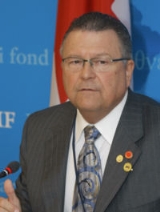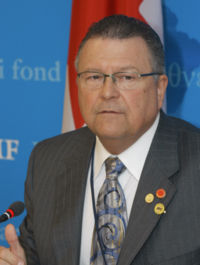
Canada Learning Bond
Encyclopedia
The Canada Learning Bond (CLB) is a grant paid by the government of Canada
to assist low-income families with saving money for their children's post-secondary education
. The CLB relies primarily on the National Child Benefit
(NCB) program to determine which families may be eligible and the tax regulations for the Registered Education Savings Plan
(RESP) to guide the eventual use of the CLB funds.
 As part of the 2004 Canadian federal budget
As part of the 2004 Canadian federal budget
, the Minister of Finance
Ralph Goodale
introduced the Canada Learning Bond as a way to encourage low-income families to use a RESP for saving money to be used for a child's post-secondary education. The maximum net benefit outlined per child was $2000 over fifteen years and the budget estimated over 120,000 newborn children would be eligible in 2004 with an estimated budget cost of $85 million. As part of the 2006 Canadian federal budget
, Minister of Finance Jim Flaherty
maintained the status quo of the CLB program by specifying that the proposed 2006 Universal Child Care Benefit (i.e., $1,200 per year per child under six) would not be considered as income when determining eligibility for the CLB. As of 2006, the program did not achieve its participation or distribution goals. Less than five percent of eligible children received the grant over the program's first two and a half years (i.e., 19,259 out of 422,048). In addition, the federal government distributed $12 million rather than the $192.5 million budgeted for the same time period. In December 2006, a spokesperson for Minister of Human Resources Diane Finley
described the launch of marketing efforts to address the low awareness of the CLB program. In a presentation to the House of Commons
Standing Committee on Finance in August 2007, the Canadian Association of University Teachers
recommended converting the CLB, Canada Education Savings Grant
, and Canada Millennium Scholarship Foundation
into one annual needs-based grant program for eligible post-secondary students.
, then the CLB payments must be returned to the Canadian federal government because the CLB is not transferable.
Government of Canada
The Government of Canada, formally Her Majesty's Government, is the system whereby the federation of Canada is administered by a common authority; in Canadian English, the term can mean either the collective set of institutions or specifically the Queen-in-Council...
to assist low-income families with saving money for their children's post-secondary education
Tertiary education
Tertiary education, also referred to as third stage, third level, and post-secondary education, is the educational level following the completion of a school providing a secondary education, such as a high school, secondary school, university-preparatory school...
. The CLB relies primarily on the National Child Benefit
National Child Benefit
The Canadian National Child Benefit initiative aims to help children living in poverty. The program is a partnership between federal, provincial and territorial governments and First Nations in Canada...
(NCB) program to determine which families may be eligible and the tax regulations for the Registered Education Savings Plan
Registered Education Savings Plan
A Registered Education Savings Plan, or RESP, is an investment vehicle used by parents to save for their children's post-secondary education in Canada. The principal advantages of RESPs are the access to the Canada Education Savings Grant and a source of tax-deferred income.-Tax Benefits:An RESP...
(RESP) to guide the eventual use of the CLB funds.
History

2004 Canadian federal budget
The Canadian federal budget of 2004 was a budget for the Government of Canada. It was read in the Canadian House of Commons on March 23, 2004 by Finance Minister Ralph Goodale of the governing Liberal Party...
, the Minister of Finance
Minister of Finance (Canada)
The Minister of Finance is the Minister of the Crown in the Canadian Cabinet who is responsible each year for presenting the federal government's budget...
Ralph Goodale
Ralph Goodale
Ralph Edward Goodale, PC, MP was Canada's Minister of Finance from 2003 to 2006 and continues to be a Liberal Member of Parliament...
introduced the Canada Learning Bond as a way to encourage low-income families to use a RESP for saving money to be used for a child's post-secondary education. The maximum net benefit outlined per child was $2000 over fifteen years and the budget estimated over 120,000 newborn children would be eligible in 2004 with an estimated budget cost of $85 million. As part of the 2006 Canadian federal budget
2006 Canadian federal budget
The Canadian federal budget for fiscal year 2006-2007 was presented to the Canadian House of Commons by Finance Minister Jim Flaherty on May 2, 2006...
, Minister of Finance Jim Flaherty
Jim Flaherty
James Michael "Jim" Flaherty, PC, MP is Canada's Minister of Finance and he has also served as Ontario's Minister of Finance. From 1995 until 2005, he was the Member of Provincial Parliament for Whitby—Ajax, and a member of the Progressive Conservative Party caucus...
maintained the status quo of the CLB program by specifying that the proposed 2006 Universal Child Care Benefit (i.e., $1,200 per year per child under six) would not be considered as income when determining eligibility for the CLB. As of 2006, the program did not achieve its participation or distribution goals. Less than five percent of eligible children received the grant over the program's first two and a half years (i.e., 19,259 out of 422,048). In addition, the federal government distributed $12 million rather than the $192.5 million budgeted for the same time period. In December 2006, a spokesperson for Minister of Human Resources Diane Finley
Diane Finley
Diane Finley, PC, MP is a Canadian politician. She serves as Minister of Human Resources and Skills Development in the cabinet of Prime Minister Stephen Harper. Of the 12 MPs in the Priorities and Planning Committee of cabinet , known as the inner cabinet, she is the only woman...
described the launch of marketing efforts to address the low awareness of the CLB program. In a presentation to the House of Commons
Canadian House of Commons
The House of Commons of Canada is a component of the Parliament of Canada, along with the Sovereign and the Senate. The House of Commons is a democratically elected body, consisting of 308 members known as Members of Parliament...
Standing Committee on Finance in August 2007, the Canadian Association of University Teachers
Canadian Association of University Teachers
The Canadian Association of University Teachers is a federation of independent associations and trade unions representing approximately 65,000 teachers, librarians, researchers and other academic professionals and general staff at 120 universities and colleges across Canada.-Principal Aims:The...
recommended converting the CLB, Canada Education Savings Grant
Canada Education Savings Grant
The Canada Education Savings Grant is a Government of Canada program, administered through Human Resources and Skills Development Canada, to assist with savings for Canadian children's higher education...
, and Canada Millennium Scholarship Foundation
Canada Millennium Scholarship Foundation
The Canada Millennium Scholarship Foundation was a private, independent organization created by an act of the Parliament of Canada in 1998. It received an initial endowment of $2.5 billion from the federal government to provide awards annually for ten years...
into one annual needs-based grant program for eligible post-secondary students.
Current program
The Canadian federal government provides the CLB to families who are entitled to the NCB and have children under the age of fifteen who were born after 2003. In the first year of eligibility per child, the family receives $25 to cover the cost of setting up a RESP with the child as a beneficiary and $500 payable into that RESP. After setup, the Canadian federal government provides a $100 CLB installment payment for each year the family remains entitled to the NCB and until the child turns fifteen. If an eligible family does not apply for a CLB after the birth of a child, then they have until the child's eighteenth birthday to apply and receive payments for the years the family was eligible. If the family does not apply prior to the child's eighteenth birthday, then the child can apply for their own RESP and receive the CLB as long as they do so before their twenty-first birthday. Once the beneficiary of the RESP enrolls in a qualified educational program, then the beneficiary receives the balance in the account through Educational Assistance Payments. If the beneficiary of the RESP does not enroll in an educational program after high schoolHigh school
High school is a term used in parts of the English speaking world to describe institutions which provide all or part of secondary education. The term is often incorporated into the name of such institutions....
, then the CLB payments must be returned to the Canadian federal government because the CLB is not transferable.

